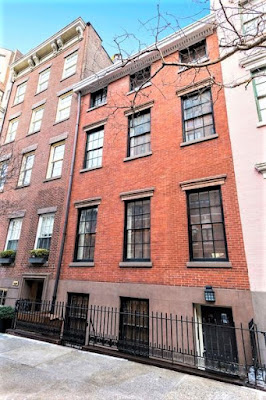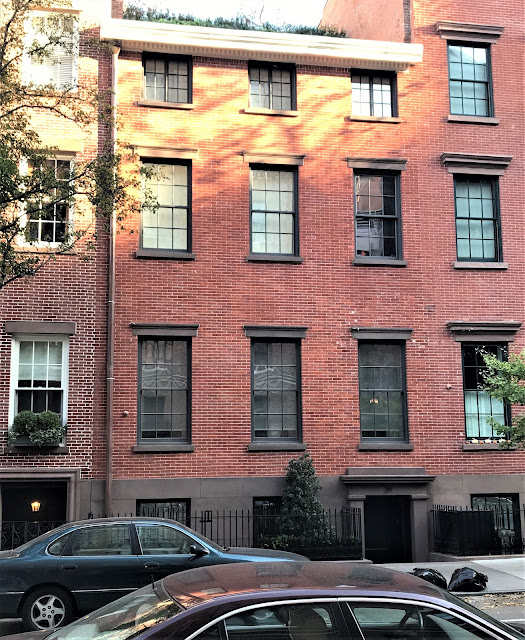Andrew Lockwood was a Greenwich Village builder, responsible for numerous structures in the early 19th century. In 1835 he purchased property on Amos Street between Fifth and Sixth Avenues, but it would not be until 1838 that he began construction on four handsome brick-faced houses.
Completed the following year, each was built for a separate client, although they were essentially identical. Their Greek Revival design included a brownstone-clad basement level, a high stone stoop, and the heavy stone entrance enframement typical of the style. A dentiled cornice ran above the short attic level.
No. 39 Amos Street (renamed West 10th Street in 1857) had been erected for Peter Omer Grilliet. He was a partner in the commission merchant firm of Grilliet & Hoguet at 4 South William Street.
By 1851 Maria Heiser Clum occupied the house. Her husband, Philip, had died in 1829 and her son, Philip, Jr., was 30 years old in 1851. It does not appear that he lived with his mother, and her residency was short. She died at the age of 67 on September 9, 1853 "of congestion of the brain," according to the New York Herald. The newspaper noted, "Her remains will be taken in the country for interment."
The house next became home to the Herzog family. Simon Herzog operated a shirt business at 35-37 Vesey Street. His son Salomon worked in the family business by 1859. The Herzogs remained in the house until about 1863.
Merchant Lewis H. Redfield and his family lived here by 1867. The Redfields cautiously rented extra space in the house in 1869, their advertisement making it clear that the roomer would have to find his meals elsewhere:
A private family will let one or two well furnished rooms to gentlemen, without board. Apply at 39 West Tenth street, near Fifth avenue.
The 1880's saw the Frederick A. Booths living at 39 West 10th Street. Booth was the treasurer of the Domestic Sewing Machine Company. He and his wife were active members in the Association for Indian Affairs, an organization that lobbied for Native American rights.
The Booths, incidentally, rented the house from millionaire James Hood Wright, who went professionally by J. Hood Wright. Born in Philadelphia in 1836, he had begun his career as a bookkeeper with the banking firm of Drexel & Company. He rose through the firm rapidly and around 1864 was made a partner.
After relocating to New York, Wright became a partner of Drexel, Morgan. He was a member of the syndicate that funded Thomas Edison's project to illuminate Manhattan. That led to Wright's becoming banking director of the Edison Electric Illuminating Company. The Wright house on Kingsbridge Road near 175th Street that was the first New York City residence to be electrically lit.
The Booths continued to be involved in charitable causes. In 1900 Mrs. Booth was president of the Free Home for Destitute Young Girls on East 11th Street. Frederick was its treasurer. The aim of the organization was:
To afford gratuitous aid to destitute girls, and especially to provide a temporary home for poor and friendless girls who are exposed to the temptations of the city, and after sufficient instruction, to provide them with positions in Christian families.
The Booths remained in 39 West 10th Street for about two decades, until May 1905. Thomas Thatcher had purchased the house two years earlier, and now sold to Thatcher Magoun Adams, Jr. The young man no doubt purchased the house in anticipation of his upcoming wedding. He married Edith Atlee Jackson on November 1 that year.
Adams already had a fascinating background. He was born in 1874 to William and Helen Coolidge Adams. Following his father's death in 1888, he was adopted by his uncle and aunt, Thatcher M. Adams and the former Frances Charlotte Adams, and took his uncle's name. He attended the private Cutler School in New York City, and the preparatory Lawrenceville School in New Jersey. Following his graduation from Yale University's Scientific School, he bought a seat on the New York Stock Exchange. Thatcher M. Adams helped set him up in a brokerage firm, Adams & Clarke in 1897.
On February 24, 1907, Thatcher and Edith a child, Thatcher M. Adams. Tragically, the infant died six days later. A second son, also named Thatcher Magoun Adams, was born in 1912.
In 1914 the Adamses moved to Mendham, New Jersey. Thatcher died there on April 1, 1916 from a heart attack brought on from pneumonia.
Herbert T. B. Jacquelin had purchased the house from Adams. A member of the firm Jacquelin & DeCoppet, organized in 1879, he had been a member of the New York Stock Exchange since 1894 and a member of its Board of Governors since May, 1912. Jacquelin and his wife, Edith, had two teenaged daughters, Marjorie and Eugenie.
The girls' mother paved the way to their upcoming debuts into society by being a patroness of the Junior Assemblies, the successors of the Junior Cotillions. Other patronesses were Mrs. Pierre Mali, Mrs. J. Pierpont Morgan and Mrs. Arthur M. Dodge.
The three dances it organized each season were "important events of each winter...among the members of the younger set in society," according to the New York Herald. Prior to the dance on December 1, 1914, Edith gave a dinner party to which several very eligible young bachelors were invited.
Edith did the same before the first of the Junior Assemblies dances the following winter season. On December 1, 1915, The Sun reported, "Mrs. Herbert Jacquelin gave a dinner at her home, 39 West Tenth street, for her daughters, the Misses Marjorie and Eugenie Rand, afterward taking her guests to the dance." It would be be the last pre-dance entertainment. In May 1916 the Jacquelins sold the house to Oliver H. Sawyer.
The West 10th Street house became home to poet and novelist Jean Toomer and his bride Marjorie Content in 1934. Toomer's first wife, author Margery Latimer, had died in childbirth two years earlier. Marjorie Content was a photographer and had been married and divorced three times.
Majorie Content photographed Toomer in the window of 39 West 10th Street in the spring of 1934. from the collection of the National Gallery of Art
Toomer was known best for his 1923 novel Cane, which dealt in part on the author's early years in the segregated South. Praised by critics as an important work of the Harlem Renaissance, Toomer bristled at being classified as a Black writer--preferring the term "American author."
39 West 10th Street as it appeared when the Toomer-Contents lived here. via the NYC Dept of Records & Information Services
The couple remained in the West 10th Street house until 1940, when they moved to Doylestown, Pennsylvania.
The stoop was removed during a renovation completed in 1946, which lowered the entrance to the basement level. There were now a dentist's office on that level, a duplex on the parlor and second floors, and one apartment on the third floor.
The house was sold to composer Jonathan Sheffer for $1.4 million in April 1993. With plans to reconvert it to a private home, he had the interiors gutted to the studs. Then, in August 2015, with no work done (other than the destruction of the 1839 interiors), he sold it for $18.1 million.
The new owners announced plans to spent another $7 million to $10 million to add a penthouse and new basement, expanding the floorspace to 7,500 square feet. Included in the work was the fabrication of a period-appropriate Greek Revival style entrance.
photographs by the author
no permission to reuse the content of this blog has been granted to LaptrinhX.com





.png)

No comments:
Post a Comment